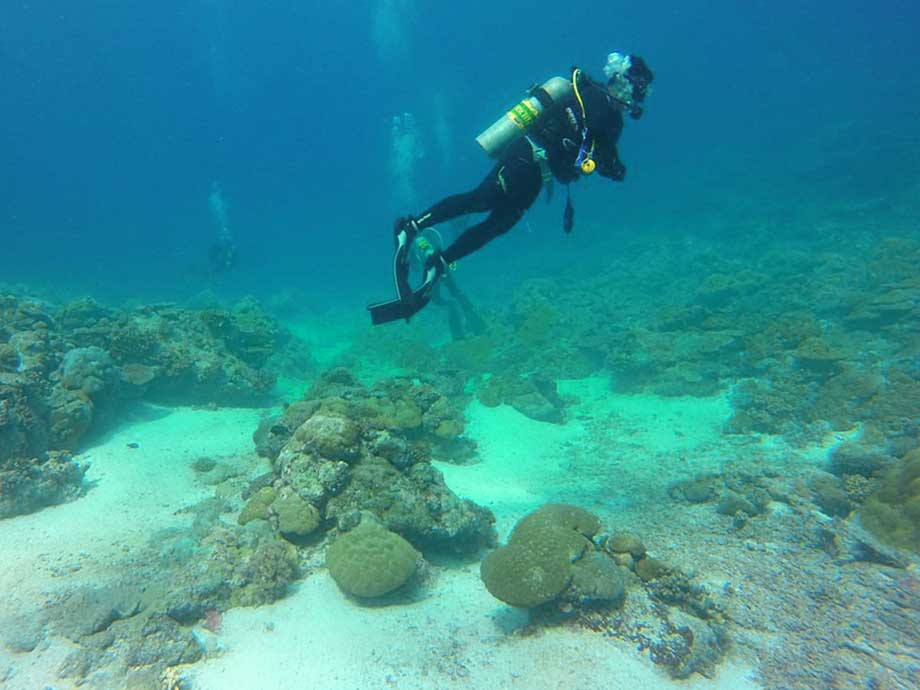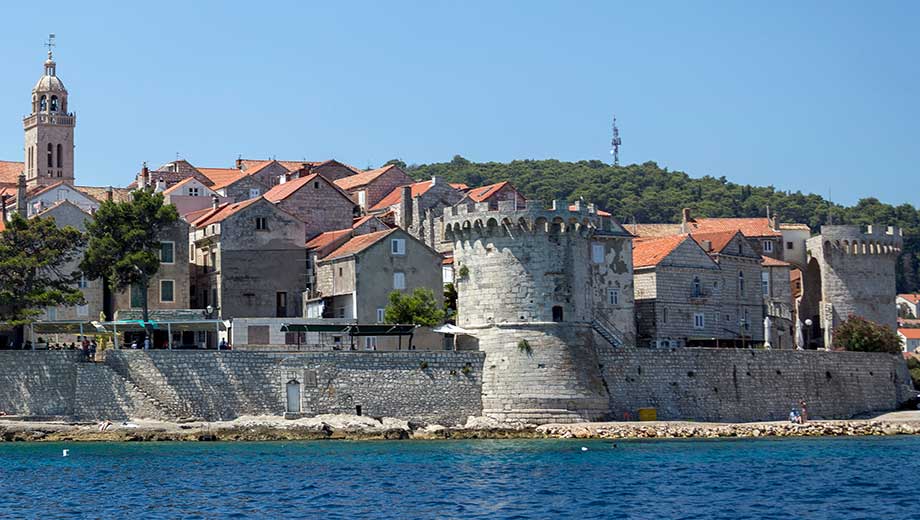Learn some Croatian before you visit Croatia! :-)
Our school offers online group & one-to-one lessons from qualified teachers – from €11/lesson!

Our school offers online group & one-to-one lessons from qualified teachers – from €11/lesson!
Mljet is the most southerly and easterly of Croatia’s large islands. The surface of the island is thick with forests and Mediterranean vegetation and the island is famous for its white and red wines, as well as olives and goat's cheese.
The biggest town on Mljet is Babino Polje, with a population of 270 of the island’s 1077 residents.
At the north end of the island Mljet has two saltwater lakes, Malo and Veliko Jezero, and on the island of in the centre of the larger of the two lakes is the 900 year old monastery of St. Mary (Sveta Marija).
 The view from Mljet back toward Prapratno
The view from Mljet back toward Prapratno
The northeastern side of Mljet was designated a national park in 1960.
The park covers 5,300 hectares, which is about one-third of the island of Mljet, and boasts flooded bays, beautiful pine woods, a host of indigenous flora and fauna, and two amazing saltwater lakes.
The lakes Veliko Jezero and Malo Jezero are about 4 kilometers in lengt together, with designated trails for visitors to hike or bike along. In the centre of the larger lake you’ll also find a 12th century monastery that we’ve written more about below!
You might also happen upon a (very much non-indigenous) Asian mongoose, a species that was introduced to the island in the early 20th century to reduce the population of poisonous snakes.
To get the most out of the national park we recommend renting a bicycle in nearby Pomena, Polae, and Mali Most. Cycling is a great way to cover more ground and the park is flat and has well-marked bike paths throughout.
Check out our post on Croatia’s other 7 national parks, which range from rugged mountains to island paradise to crystal waterfalls.
 The National Park of Mljet
The National Park of Mljet
Mljet is well-known for its clean waters, which draw divers from far and wide, however surprisingly few visitors realise that Mljet has an actual coral reef, which is located on one side of Veliko Jezero (within the Mljet National Park).
Although the coral has been harmed over the years as a result of invasive algae species and rising water temperatures, the biodiversity around the reef is truly amazing and worth a dive!
This is also the only coral reef in Croatia, hence a must-see for divers and aquatic enthusiasts.
 Coral Reef Diving
Coral Reef Diving
This massive structure on the Polače seafront is impossible to miss, in fact it's so enormous that the road now actually runs through the middle of it!
This opulent palace, which dates from the 5th century, features a rectangular floor plan with towers on the front corners divided by a pier. A late Antiquity fort and an early Christian church are among the other ancient relics dispersed across the area.
 Roman Palace at Polače on Mljet
Roman Palace at Polače on Mljet
Over centuries past, many caves have grown naturally around the coast of Mljet, and one of the most impressive of these is the “Odysseus Cave” on the island's southern coast, near Babino Polje.
The cave was given its name in honor of the Greek hero Odysseus, and some locals claim that this is the actual cave from Odysseus' mythical voyage, in which he sought refuge after being shipwrecked nearby, however more recently this tradition has been linked to the island of Malta.
The cave is large and egg-shaped, and the rock formations inside provide a spectacular sight. Access to the cave is through a 20-meter-long tunnel from the sea, and can be entered by swimming or sailing: the opening is big enough to allow small boats to sail through.
The cave takes about 45 minutes to reach on foot from Babina Polje along a well-marked path, hiking through relatively rocky terrain. Once you arrive, we suggest you change into your bathing costume, take a deep breath and jump into the water from above the cave!
Jumping into the water is an amazing experience, and there’s a rope jutting up from the cliff and a very steep (and improvised) staircase if you want to return to the top to take another leap into the blue.
If you visit the cave during the summer months we suggest you plan to arrive around noon, in time to see the sun's rays casting a brilliant gleam on the water.
 "Odysseus Cave" near Babino Polje
"Odysseus Cave" near Babino Polje
Did you know that swimming is allowed in both of the saltwater lakes that form part of Mljet National Park? This makes Mljet the only national park in which swimming is permitted. Visitors are also allowed to sail or kayak in both lakes.
Originally thought to have been a freshwater lake, Veliko Jezero is connected to the Adriatic Sea only via the narrow Solinski Channel. Since there are no alternative outflows to the sea, the water in the Veliko Jezero is replaced only gradually, which results in a lower salinity than the Adriatic. The temperature of the lake water is also warmer than the temperature of the surrounding sea in the summer and colder in the winter.
The water of the smaller lake, Malo Jezero, comes from both rainwater and an underground stream connecting both lakes. As a result, in the summer the water is even warmer (and less salty) than Veliko Jezero, while in the winter, it is much colder than both the open sea and the larger lake.
Swimming hasn’t been allowed in other national parks like Plitvice Lakes for many years, the park authority has also recently banned swimming in Krka National park. In both cases this restriction is about protecting the natural environment within the national parks.
 Malo Jezero and Veliko Jezero
Malo Jezero and Veliko Jezero
On the southern side of Veliko Jezero it’s possible to visit the tiny island of St. Mary, on which you’ll find a picturesque monastery. The monastery was built in the 12th century by the Benedictines, but in the centuries since then the structure has seen numerous alterations in style and appearance.
To get to the monastery, you can take the boat from Mali Most or Pristanite that departs every hour. You can also rent a kayak to get there, which we recommend as a unique experience. Last but not least, of course you can also swim to the island, but only if you don’t plan on buying any (non-waterproof) souvenirs!
The park is open every day from 8 a.m. to 8 p.m. during the high season, and from 9 a.m. to 5 p.m. during the low season.
 The island of Sveta Marija on Mljet
The island of Sveta Marija on Mljet
Mljet boasts not only famous lakes, but also famous mud! :-D
In the lowlands near the town of Blato (which means literally “mud”) you’ll find reeds and water instead of vines and vegetables. These deep sinkholes contain only shallow water but beneath that deep mud, and the area has developed into rich swamp- and wetlands.
Walking too close to the “lakes” is unsafe for humans, but the area is a paradise for animals and plants: here you can find ducks and coots, eels and frogs, see turtles swim peacefully, and endangered species of dragonflies fluttering over the water surface.
The resulting lakes are unusual and picturesque, cast against a backdrop of green and wooded karst hills – definitely worth a visit!
 The "muddy" lake near Blato on Mljet
The "muddy" lake near Blato on Mljet
Mljet is beautiful, unique and offers the inquisitive visitor a wide variety of things to do.
You can also read here about whether we think Plitvice Lakes is worth visiting (spoiler alert: it’s not an unconditional “yes”) along with some tips on planning your visit.
Since the island is relatively small, getting around is easy. Mljet is also unusual in that there is no large-scale tourism on the island, hence it remains calmer and quieter, even during peak tourist season.
So: don't forget Mljet when you're planning your holiday! :-)
The official website of the Mljet tourist board
Wikipedia page about Mljet
We’ll be happy to tell you more about our language school and the learning options we offer. Feel free to contact Andrea directly for a chat about any questions you might have!
